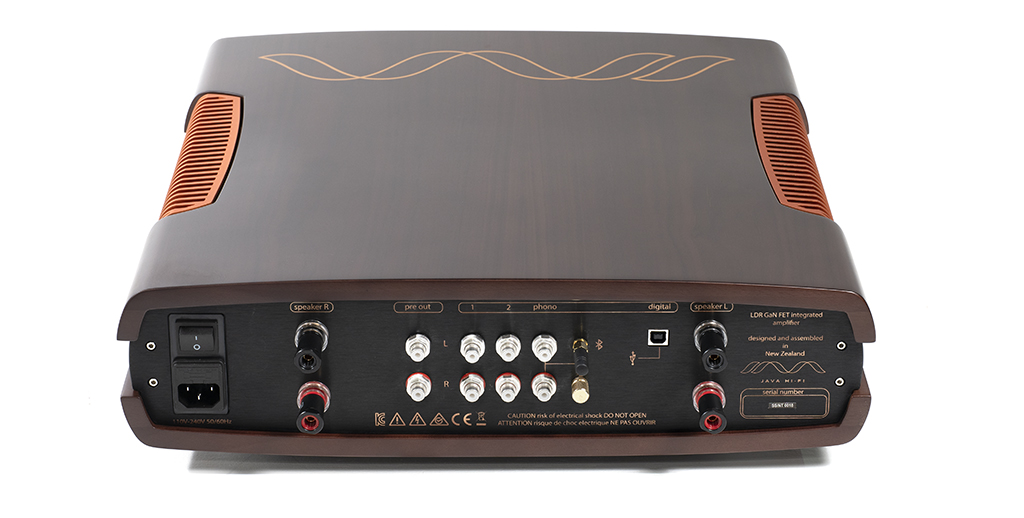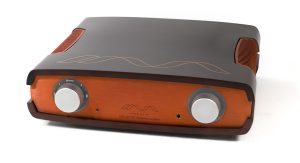The Java Single Shot Integrated Amplifier
Class-D Perfection

$8,995 -$9,495 (finish dependent)
Spoiler alert. The Java Integrated is a Class D amplifier. Just in case you’re predisposed to a certain idea of how Class D is supposed to sound, you need to abandon it, or stop reading. To be fair to Java’s Martin Bell, I’ve always been Class D adverse, but I keep investigating. I didn’t like coffee until I was 50, and then one day it all clicked. Ironically, this amplifier is called the Java. Weird.
Taking advantage of the latest GaN-FET power amplifier module technology, the Java rewrites the book on whatever degree of harshness you’ve associated with Class D designs. Remember how awful digital audio used to sound? 20 years’ worth of development and it sounded pretty darn good. If you can think of this in the same vein, it makes sense.
Cursory break in with a pair of vintage ESS AMT-1b speakers immediately feels different in an ear perking way. The vintage AMTs are merciless with amplification that is even the slightest bit harsh, so this is a great torture test. Passing this test with ease, moving on to the main system with the new YG Acoustics Cairn speakers in for review is equally interesting – the Cairns are not overly bright in delivery, but highly resolving. Again, any frequency response or tonal anomalies will be instantly revealed. This is a fantastic combination.
Smooth, smooth, smooth. Smooth and tonally correct in a way that if no one told you this was a Class D amplifier, You wouldn’t ask the question. Trying a few more sets of speakers on hand vaporizes any lingering animosity towards this form of amplification. Past experience with Class D always exhibits more speaker sensitivity than normal, much like an SET tube amplifier. The result is usually brilliant or awful. The Java suffers none of these issues.
Working through everything on hand from vintage Acoustat ESLs (which due to their overly capacitive nature are tough to drive for most amplifiers) to the current Peak Consult Sinfonas that are my main reference is a breeze. Where the Peak’s are slightly forgiving in the same way that the outgoing Sonus faber Stradiveris were, the YGs and the Team Fink Kims are both highly resolving yet remain a lovely match. If you love listening way, way into a recording, this is a rewarding combination

A sonic and stylistic decision
I submit we have a lot of people out there wanting a high-performance music system, considerably more involving than a soundbar solution, more than willing to pay for it that don’t want to become audiophiles. That’s not to say that an audiophile can’t love the Java, but being that it is somewhat upgrade adverse and self-contained it may not appeal to those that constantly want to tweak things. Of course you could plug a different phonostage or DAC in, but it defeats the primary purpose.
The onboard MM phonostage delivers excellent results with the Technics SL-1200G (featuring an Ortofon Concorde Silver cartridge) and the Linn LP-12 table (with Adikt cartridge) in for review. Again, just as not all music lovers become audiophiles, not all music lovers that buy a turntable purchase thousands of albums either. We’ve certainly come across numerous end users that have 50-200 albums and are perfectly happy with that. For the random vinyl enthusiast, this will be more than you ever need to enjoy your collection.
Adding the Quadratic MC-1 step-up transformer to the MM input, taking advantage of the recently reviewed Luxman LMC-5 and Rega Apheta 3 MC cartridges proves just how good the onboard phono is, so more obsessed vinylistas can still play in this sandbox without concern. The noise floor is ultra-low, and the sense of space presented large. The onboard phono in the Java is easily the equal of anything you might find in the $800-$1,200 range and remember, no extra cables! Considering what you’d spend on four sets of mains cables and interconnects for a preamp, DAC, phonostage and power amplifier, the Java is almost free.
The onboard 24/192 DAC utilizing a pair of Burr-Brown PCM1794As in mono mode, with DSD being converted to PCM before playback delivers equally enticing results with digital files. Your favorite streamer, or laptop can be connected via USB. Keeping in with the general vibe of this amplifier, the Pro-Ject Stream Box S2 (about $800) makes the Java an effortless Roon endpoint. You can also stream from a tablet or phone via aptX Bluetooth.
Thanks to eight different finishes, the Java will integrate into any décor with ease. The high gloss and satin matt cases are only $8,995, with the five luxury wood veneer options (like our gorgeous review sample) bring the price up to $9,495. The Java you want is only a few clicks away thanks to the online configurator.
Thanks to Class D amplification, the Java only weighs 27 pounds, and offers a compact remote. Everything is CNC machined to perfection, and it feels like a much more expensive product. The input selector and volume controls both feature a backlit display, making them very easy to read.
In addition to the USB digital input, there is the MM phono input mentioned earlier, and two line-level RCA inputs. A variable preamplifier output (also RCA) is available for those wanting to add a powered subwoofer to the mix and a ¼-inch headphone jack on the front panel. Integrating with a REL Carbon Special sub and the YGs was easy as pie to configure.
As it goes with everything else, the headphone amplifier should keep you happy if you’ve got a pair of $200 – $1,000 headphones, but just like that record collection, I suspect the person buying a Java is going to make the same commitment to headphones as they are vinyl. Find a nice pair of $400 – $600 cans and enjoy. Trying a few different things from Audeze, Sendy, and Focal all went without a hitch.
The final frontier
While I haven’t had the ability to hear every Class D amplifier out there, of what I’ve heard, another commonality is their inability to achieve a neutral tonal balance. Voices always sounded somewhat electronic and grainy, as did stringed instruments. Depending on the model of amplifier, this was better or worse, but in the case of the Java, tonal balance, texture and shading is just right.
Whether listening to violins, piano, or acoustic guitar, there is a sense of rightness that allows your brain to disengage from analysis and fall into the music. I’m sure you have your favorite solo vocal tracks to investigate this with, but I lean towards Rickie Lee Jones, Aimee Mann, and Johnny Cash, merely because I’m intimately familiar with them.
Purposely heading for the most difficult tracks I know in terms of musical complexity, pushing the Java, there was never a torture test this amplifier failed. Even tracking through a higher amount of classical music than normal, delivered fantastic (i.e. fatigue-free) results. No matter what kind of music you love, the Java will satisfy you. However, if you really love electronic/techno music, the high power, and rock-solid bass control the Java delivers is very impressive. The opening track in Peace Orchestra’s self-titled album, “The Man, Pt.1” is simply enormous in its delivery through the YGs. There’s so much extension and sheer grip here, these small stand mount speakers sound like floorstanders. Ditto for Theivery Corporation’s The Richest Man in Babylon. For those of you that love classic rock. Rush’s epic 2112 was highly satisfying through the Java and the big Peak Consult speakers. Admittedly, listening levels did exceed 90dB here!
The Java integrated amplifiers come as a single shot model, with 200 Watts per channel on tap, or the double shot model, with twice as much power. As so much of my listening is done in a 78-90dB environment, and most of my speakers are fairly sensitive, the single shot amplifier was never remotely close to being maxed out. If you have relatively power hungry (like maybe some Magnepans) speakers, you may want to pony up an extra $4,000 for the double shot model.
Sheer brilliance in every way
This amplifier is a massive success on every level. It looks fantastic, sounds fantastic, and has a balanced amount of performance in every aspect. The amplifier is far and away the most natural we’ve heard from this topology, and the functionality is just right. Should you be looking for a great two channel music system anchor, I can’t suggest the Java highly enough. Adding a table, pair of speakers, phones and some equally great cable (we used Tellurium Q Black II interconnects, speaker cables and power cord to excellent effect with this amplifier) and be all in for $15,000 – $25,000. You can’t even buy a CPO Mini Cooper S for that kind of money.
The Java will win over two main users to be sure. The music lover lacking audiophile ambitions, and the audiophile wanting to get off the upgrade marathon. (or perhaps downsizing) But anyone who hears it will enjoy it tremendously. The Java is an easy candidate for one of our Exceptional Value Awards for 2023.
Put this one in the love column.




